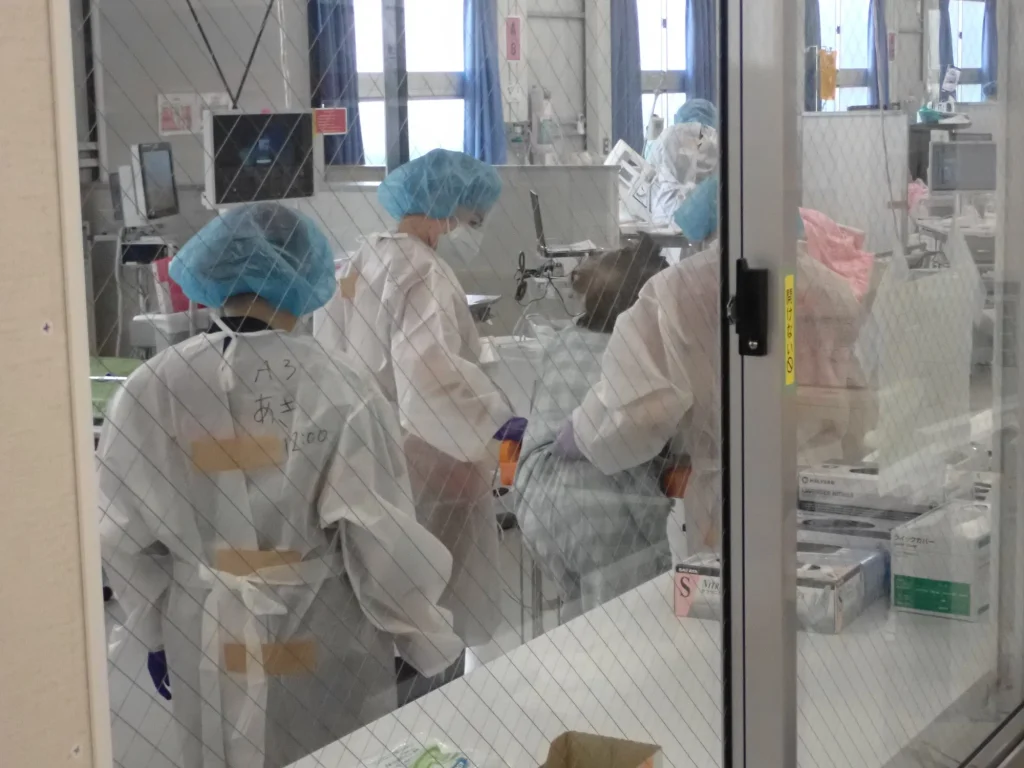| Aki Mina (Nurse) As of February 2020, HuMA is conducting medical assistance activities to counter the spread of the novel coronavirus in Rishiri Island, Hokkaido. This iteration is a re-edited article of what we covered during assistance activities at Osaka COVID-19 Critical Care Center in July 2021 to feature passions of healthcare workers who work on the front to address the pandemic. We interviewed Ms. Aki, a nurse who has engaged in medical care twice for patients with severe symptoms at the Center since winter 2020. Maintaining frontline medical services like relaying a baton Soon after starting operation of Osaka COVID-19 Critical Care Center, a serious shortage of manpower hit the medical front. At the request of the government saying “Please extend a helping hand even if it will be a short period of time,” healthcare workers from across Japan were dispatched one after another on a 7-to-10-day basis, maintaining frontline medical services as if relaying a baton. While serving as a part-time nurse at a hospital in Osaka, I also work at a relaxation salon. I became interested in disaster medicine as I thought that my skills such as my past experience of engaging in acute care can be useful for emergency medical activities. When I was wondering, “How can I be involved with such assistance activities,” I had a chance to get to know HuMA’s engagement and decided to join this time’s activities at Osaka COVID-19 Critical Care Center as my first mission. Osaka is where my own daily life is based. I think that my passion “for the sake of my local community” gave me a push toward the participation as well. At the Center, we worked in shifts that divide a day into three time zones. My head and body were running at full capacity all the time when working there. A protective gear with a face shield and an N-95 mask was just like a sauna suit. The air conditioner temperature was set relatively high for patients’ condition, and we couldn’t turn it down even if we felt hot. Nurses hold conferences within a team including doctors, decide what medical care they will provide for each patient, and take action. While it is common for a nurse to care two patients at hospital ICUs, a nurse is assigned to four patients at the Center. Many of the patients transported to the Center could take a sudden turn for the worse. In particular, patients with pneumonia spread in their lungs needed care called prone therapy. This treatment intends to make their breast work better by repositioning patients every 2-6 hours, which requires 6-8 medical staff for making it happen because we have to also move tubes and other equipment connected to patients. The entire team was providing medical care around the clock. |

My fellows who supported me in the tough days In the “red zone,” an area where beds of severely-ill patients were, I have been present at patients’ deathbed quite a few times. What we thought was important as nurses then is caring for patients’ families. They are supposed to stay by their beloved one until he/she passes away, but their wish won’t come true. Their sorrow is immeasurable. We therefore set up a video call for families to spend the final moment of their loved one’s life so that they were at least able to see the face and speak to him/her even though it was virtual. “It is too sad to see your loved one in a body bag after he/she is gone. I want you to at least spend time together until the one’s last breath,” I told to patients’ families with my eyes flowing tears helplessly. As there was no way to wipe such a flood of tears in the protective gear, I sometimes found my face skin peeled off due to sweat and tears while taking off the gear after a series of treatments. Although the situation was grueling both mentally and physically, my like-minded fellows provided a very powerful underpinning. Nurses gathered at the Center were from different hospitals and had different specialties. However, it was common that they were “home run hitters” with their own skills and personalities standing out. Some nurses were extremely splendid in practical nursing care, while some others stayed considerate of patients’ feelings, which made me think that the Center worked out through our team play as each and every one of us applied what we were good at. I learned every day inspired by my respectable fellows. Between the tense medical front and the peaceful everyday life When I returned to my daily life after working at the Center, I felt “Oh, the world is in peace.” There was a gap between the tense workplace and the rest of the world. I thought “Only those who suffer the novel coronavirus can actually become aware of the threat. That shows how difficult COVID-19 is.” The other day (back in July 2021), there was a coverage saying “no death case due to COVID-19” in Osaka, and I was very happy to hear the news. That is because I saw many people regret at the Center. “Maybe if I had done this way, I would have not suffered like this.” “Maybe if I had not done this way, my beloved family member would have survived.” I sincerely hope to reduce even one more of those who have such regrets. Besides, I am committed to living up to it so that I myself will never regret. When there is a request for dispatch, I will engage in the activities at the Center again. |
By Yuki Domoto
Translation by Mariko Hirata
(PR volunteers)


